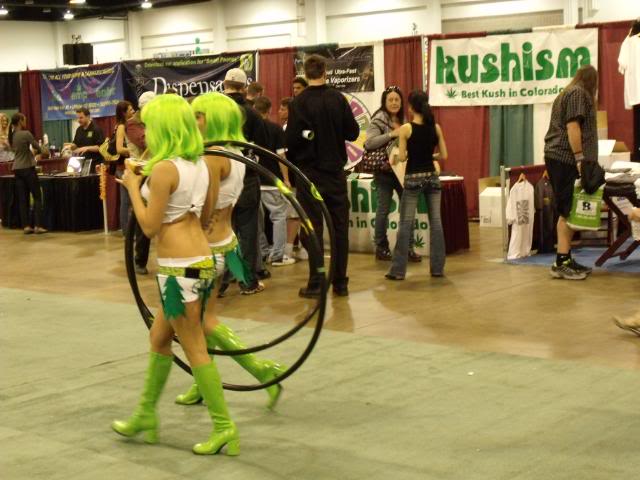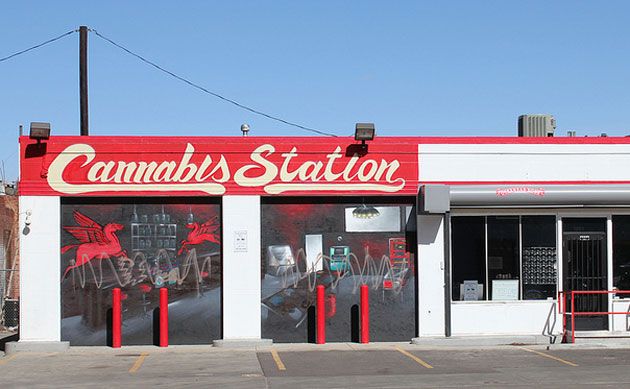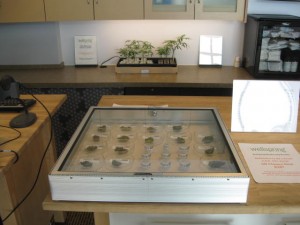[Note: “The Retail Explosion” is also Part 7 of Cannabis Commerce in the USA, found in its entirety here.]
I can pinpoint the exact moment I realized I was living in the epicenter of a retail explosion. It was a winter night in February 2010. Driving to my cannabis cultivation class, along the usual route down South Broadway, I encountered a phenomenon so startling I screeched to a halt in the middle of the thoroughfare: on three of the four corners where South Broadway crosses Asbury, green-neon cannabis leaves probed the nighttime cityscape.
A week earlier, the crumbling blacktop currently hosting Walking Raven Medical Collective, Little Brown House Dispensary, and The Green Depot stood vacant, a deteriorating vestige of a bygone era abandoned by the previous lessors, out-of-business car dealerships. Now the intersection was reborn, a highlight on South Broadway’s burgeoning dispensary row.
In a delicious irony, the shining star of today’s economy has supplanted the mainspring of last century’s economy. Think the owners of these deteriorating lots are glad cannabis commerce saved their ass-ets?
Urban renewal, cannabis style

Little Brown House Dispensary, former used car lot office, before adding its postmodern $50 million Frank Gehry designed wing.
Faced with the prospect that South Broadway, minus its used car dealerships, was descending into blight, Denver’s Urban Renewal program has been slowly but surely transforming the artery into a pedestrian-friendly boulevard with a treed median strip. In theory, fresh pours of concrete attract fresh mercantile ventures.
Were an ever-increasing number of medical marijuana outlets what the city fathers had in mind to fill the void? Well . . . extending the antique district was probably closer to the original intention. Alas, in 2010 public ardor for Victoriana lacks traction to fuel a commercial renaissance. There’s just not that much demand for feathered bonnets and fainting couches.
So, what is there plenty of demand for? It turns out to be dispensaries. And dispensary row seems to be working out for all concerned.
25 in 1
In my “hood,” nobody’s oblivious that twenty-five dispensaries have moved into a one-mile radius with an unprecedented assault on retail hearts and minds. Finally afforded an opportunity to strut its stuff, cannabis has penetrated more storefronts than coffee and wireless put together. This conquest took all of six months.
Was I brilliant enough to predict that? No. Did anyone I know predict that? Er, no. It just sort of happened. Twenty miles to the west, even the most optimist cannabis commerce fans would have a hard time believing that in Boulder, the ratio of dispensaries to pharmacies would skyrocket from 0-16 to 100-16 in the same six months!
Hundreds of dispensaries have put down roots in and around Denver’s fertile, pro-marijuana – and not just for medicinal purposes, thank you – climate.
Additionally, the previously wilting Classifieds section of Denver’s Westword has been rejuvenated (ditto for LA Weekly), swelling with page after page of retail cannabis commerce ads. Get your doctor’s note here. Cooking With Cannabis classes here. Rent grow space in a secure warehouse here. Buy your grow tents right here.
Retail history didn’t happen overnight
This explosion is unprecedented in the history of retail. The Chamber of Commerce is stumped. When have 25 shops offering anything – animal, vegetable, or mineral – established root so rapidly in any neighborhood? Retail cannabis commerce, in the form of dispensaries and spinoff businesses, has rearranged the status quo in the Queen City of the Plains. What’s next, dispensary tours on double-decker buses? Close. The Boulder Bud Cruise operates a single-decker conveyance.
Twenty-five dispensaries in a one-mile radius didn’t happen overnight . . . although it seems like it did. After Colorado voters passed Amendment 20, Medical Use of Marijuana, in 2000, Denver’s dispensary scene germinated for the better part of a decade. California passed the Compassionate Use Act four years earlier, in 1996; it took time to boil there, too. What halted the parade of progress?
The delay can be traced mainly to the lack of uniformity in medical marijuana laws. In Colorado, each city was given leeway to apply, not apply, or interpret as it best deemed fit, the medical marijuana laws vaguely etched into the Colorado State Constitution. Counties, too, can add or subtract their own ordinances, though they haven’t yet made their presence felt to the full extent counties in California have. State laws collided with longstanding federal drug laws, creating legal gray areas – and lots of billable hours for pro-pot attorneys.
It took time for all those local regulations to work through “the system.” Doctors had to be certified to prescribe cannabis as well. That was another agonizing process. In 2009, legalese on a page finally materialized into brick and mortar dispensaries on a corner.
Regulations were and are even more confusing in California. There, the state also allows each municipality leeway to interpret the law. Counties further obfuscate the process by tailoring their own regulations – and collecting their own fees. That’s one big reason it took four years longer for the first dispensaries to emerge in the Golden State. No one ever said overcoming the forces of prohibition would be easy. It wasn’t. But activists ultimately carried the day.
A wonderful day in the neighborhood
In Colorado and California, at least, the medical marijuana gods are currently granting wishes to an appreciative if still incredulous populus. Let me go down my own list and check off the retail wishes that have been granted so far:
- In less than five minutes, I can walk to a store that will sell me the High Times centerfold buds that have been verboten my whole life. Now I can buy as little as a pre-rolled joint for $10 that I can milk for four days. Check!
- I can walk to a cultivation store, where well-trained attendants will instruct me on the most efficacious methods of conducting botany experiments in the comfort of my own home. Check!
- People now happily working in retail cannabis commerce establishments are contributing epic taxation payoffs to local, state, and national governments, and public welfare projects are being funded with the proceeds. Not quite! Got the first part, not the second.
But an awesome start, nonetheless!
Muscle Beach Medicine

DISPENSARY DOLLS: Members of the Greenland national rhythmic gymastics squad, sporting phosphorescent lichen wigs and go-go boots, cruise the cannabis convention.
The Queen City of the Plains has competition in the dispensary sweepstakes. The City of the Angels has both a head start and a much bigger population base to support its 584 dispensaries in May 2010 (not for long, if the LA District Attorney’s office has its way; the whole industry is presently in a constant state of flux).
Amidst the familiar sites along Muscle Beach – the rollerskating guitar players, the guy juggling a bowling pin, a ping-pong ball and a chainsaw, the Korean-owned t-shirt shops – a dozen or so dispensaries have blended into the boardwalk freak scene. Sandwich-board clad barkers announce to passersby that “the doctor is in,” ready to prescribe and sell like they’ve been there forever.
What does this tell us? It tells us that pent-up demand for cannabis, whether it’s called “medical marijuana” or “the dank,” is somewhere between vast and infinite. That demand had to be satisfied on the retail level.
Cannabis sativa vs. coffee arabica
Can you name a retail phenomenon that has exploded like this perfect storm? I can’t. Coffee comes closest. But cannabis sativa vs. coffee arabica is not a fair fight. Sure, lots of coffee shops have opened all over the USA – over the course of 20 years, or since homo americanus discovered java comes in varieties that are considerably more upscale than Maxwell House in a can. But a cup of joe still costs around a buck fifty, and a pound of “Holiday Blend” costs like 12 bucks.
Contrast this with joints (marijuana cigarettes) selling for ten bucks, with pounds changing hands for $4,000 plus. That’s a little more impactful. Where is the ripple effect of coffee? There are no indications that folks are growing, or planning to grow, their own beans to trade with friends or sell the “overgrow” to the Starbucks on Evans and University. There is no commerce in coffee seeds or clones.
So, while coffee shops are ringing up a buck fifty here and twelve dollars there, medical marijuana dispensaries are ringing up twenty bucks here and 400 bucks there. All day long. Think some of these proceeds might benefit the community taxed at local sales tax rates? Platte Park could put up a marble post office.
In Denver, the Santa Fe art district boasts dozens of galleries in about an eight-block strip. Things get pretty vibrant on “First Friday” art walks. That’s a strong retail showing. However, the rest of the month can get a little sleepy. When things get tough economically, non-essential purchases like fine art are the first to go . . . while dispensaries are the first place people go to.
If you see it, you will want it
Human Nature 101 dictates that if you can see it, you will want it. First step is discovering that an actual dispensary has moved into your neighborhood, in between the barbershop and the pizza “joint.” Step two is setting foot inside.
The Miron mantra, “demand will stay the same after legalization,” disregards the longing, emanating from the human psyche, when twenty succulent strains of ganja, groomed and preening in a display case, compete for affection like puppies in a pet shop.
It’s true that if you don’t like tobacco, it doesn’t matter if 5 or 50 cigarette shops move into your neighborhood. But, if you never tried tobacco, wouldn’t you want to know what the fuss was all about?
Further stimulating the public’s curiosity, it’s hard not to notice quite a few head shops and cultivation shops adding sparks to the retail firestorm. The success of grow supply stores has forced the Home Depots of the world to carry an extensive selection of grow lights and fertilizer, too. Basically, the public has demanded plenty of convenient outlets to indulge its predilection for cultivating and consuming cannabis. And that wish has been granted. Big time.
Gonzo for ganja
Compare this heretofore unheard of availability, and the craving it inspires, with the wish to procure even one sight-unseen strain of exotic, from a friend of a friend, for a one-time buying opportunity. That’s the Neanderthal modus operandi which defined the ganja acquisition process until a year ago – and remains in effect outside of the enlightened communities that permit the operation of medical marijuana dispensaries. In areas where dispensaries are in full swing, the cannabis purchasing process has simplified to the point where it’s as painless and mindless as buying Rice Krispies.
If you have a hankering for a particular example of “the kind” there’s every chance one of your favorite outlets will have it. You can select your strain (I almost said “brand,” but that’s still to come) from a dispensary’s display of sativa and indica just like you can pick your favorite single malt from a liquor store’s display of highland and lowland Scotch. Civilized.
What does all this mean in terms of pot-ential taxation revenue? One meaning is clear: underestimating a public gonzo for ganja is a mistake. All evidence points to a great deal of upward pressure on the retail sector. There’s another economic indicator experiencing upward pressure.
Creating jobs We Really Like
There are “job” jobs; then there are jobs we really like. Some jobs put food on the table. That’s helpful. Then there are jobs that uplift us and make us feel more alive. They’re even more helpful.
In his campaign, President Obama talked about creating millions of green jobs in alternative energy. Haven’t heard much about those lately. But I’m always hearing about new and different avocations in the cannabis industry, from budtenders to ladybug ranchers – apparently the orange assassins eat spider mites plaguing indoor plants.
By and large, people in the cannabis industry appear uplifted to be working in their preferred industry. That said, financial markets value the number of jobs that are being created more than how uplifting these jobs may or may not be. They also distinguish between “new jobs” and “job shifting.” Are these opportunities in cannabis commerce “new jobs,” or do they represent “job shifting?”
In other words, would the same people be working at Jack-In-The-Box flipping burgers if they weren’t working at dispensaries rooting clones? If so, according to economists, that would be “double counting” the same jobs. They’re entitled to that traditional view.
I see things a little differently; I say, jobs we really like should count double. That’s what Albert Einstein had in mind when he said, “Everything that can be counted does not necessarily count; everything that counts cannot necessarily be counted.”
Conclusion
I’ve set out to cover the full spectrum, the enormity of the 2010 pot phenomenon, above and beyond survey results and seizure statistics, in an effort to identify all the factors that go into calculating MPMTR (maximum pot-ential marijuana taxation revenue). The higher the figures, the more persuasive the figures. What are persuasive figures? Figures that persuade politicians to get off the fence and push through legalization. What else is there?
What does the retail explosion have to do with persuasive figures?
Let’s envision the Bay Area, LA, and Denver as test sites for cannabis commerce vis a vis the dispensary model. Imagine everything that’s happened in the last year and half as if its one big “product launch.” It’s pretty hard to dispute the preliminary results from these test markets. The public has embraced buddage beyond anyone’s wildest dreams.
At the end of Part 6, our running tally of MPMTR stood at $67 billion. In response to the overwhelmingly positive response in every retail market cannabis has been tested, Cannabis Commerce attaches the value of +10%, or $6.7 billion, adjusting our forecast to $73 billion.
Next section preview
Like water finding its own level, the job creation, economic stimulation, and retail explosion I’ve described are examples of natural selection at its finest.
But there’s another highly calculated factor at play, conceived and executed by master psychologists that know everything about persuasion. It’s a triumvirate of advertising, marketing, and publicity rolled into one unrelenting, inescapable, hypnotic force. This all-pervasive force already champions the cause for free! What could it be?







